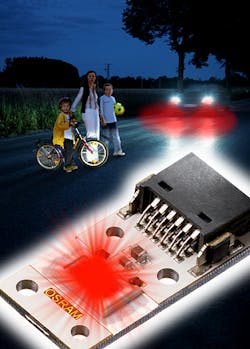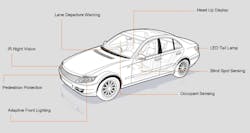SEVUGAN NAGAPPAN
Unforeseen accidents are nothing new, but the advent of safety products such as antilock brakes, seatbelts, air bags, and electronic stability control have helped drivers feel more secure for years. Now, automotive safety features such as infrared imaging, laser sensors, light-emitting diodes, and semiconductor technology are surpassing human abilities, enabling drivers to see in the dark, see around corners, and sense hidden threats from behind and in blind spots.
In recent years, innovation in passive vehicle safety has reached a plateau with most new models achieving five-star safety ratings. However, passive safety features only minimize damage after impact and are not as effective at prevention. Auto accidents still rank as the leading cause of death for all people between the ages of 2 through 34, according to the National Highway Traffic Safety Administration's 2006 Traffic Safety Facts report.
The good news is advancements in electronics and semiconductor technologies—illumination, sensing, and visualization solutions, in particular—are enabling the newest active safety features destined to be market-ready. Some features are available today while others are on the horizon. Active safety features enabled by forward-thinking semiconductor manufacturers include: near-infrared (NIR) night vision that uses imaging technology that provides high-resolution visibility in the darkest road conditions; pre-crash sensing to eliminate impact-related injuries; advanced driver assistance systems that help drivers stay alert behind the wheel; directional headlights that conform to the direction of the road; dynamic stability and traction control that adapts to changes in road conditions.
Pro-active IR
For some drivers the idea of having cameras and infrared (IR) LEDs or lasers in a vehicle is unconventional for in-vehicle safety. However, the reality is that infrared solid-state lighting technology is one of the driving forces of active safety applications. Breakthroughs in active-infrared (IR) technology not only surpasses traditional heat-sensing thermal-IR imaging in performance and cost-effectiveness, but also allow for integration into a much wider variety of practical safety applications. The advent of active IR has developed an entire new industry that is exploring practical applications like automotive safety.
With an unprecedented level of scalability, active-IR allows for the manufacture of very small photonic LEDs and lasers that can be seamlessly integrated into the interior and exterior design of a vehicle. These tiny light sources illuminate the objects observed by the cameras that collect three-dimensional data used to trigger active safety features such as driver warning systems, night vision, and intelligence features that enable cars to adapt to changing conditions.
Shedding light
One consistent cause of traffic accidents is the lack of adequate illumination for the driver. Improper illumination may be caused by dim headlights, weather, or driving conditions. According to the National Safety Council, traffic deaths are three times greater at night than during the day, simply because a driver's reaction time depends on their ability to see clearly the dangers that lie ahead. The next generation of automotive safety features will greatly extend the capacity for sight into long, dark stretches of road where vision and reaction time are compromised. Near-IR night-vision systems will assist nighttime drivers with high-resolution images of hazards in the road that would be otherwise remain cloaked under the darkness of night (see Fig. 1).
Automotive NIR night-vision systems will not only provide high resolution, they will image obstacles or impediments in the road ahead with an unprecedented level of contrast. The systems incorporate an infrared light source—either an LED or laser—a camera, and a head-up display. Most night-vision programs in vehicles currently on the market rely on less-efficient incandescent light sources. Improved vision with NIR technology will empower drivers with the ability to respond to danger within the same amount of time needed during daylight hours.
In addition to increased nighttime visibility, NIR solid-state light sources used with sensors provide unparalleled intelligent feedback and safety assistance to other alert systems within the vehicle. Pedestrian protection systems raise the hood before impact to reduce the likelihood of head injuries to pedestrians (see Fig. 2). Pre-crash sensing programs can actually determine which airbags, if any, are best-suited to deploy within the vehicle thereby preventing unnecessary injuries to the driver and other passengers. Paired with a solid-state camera such as a charge-coupled device (CCD) or a complementary metal-oxide semiconductor (CMOS) camera, NIR LEDs can be used to monitor obstacles very near to the vehicle to determine the position and point of possible impact. Such IR LED technology enables systems within the vehicle to sort out the real dangers from the ordinary objects that are sure to pose no threat to safety.The inside scoop
Threats to automotive safety often reside inside the cabin of the vehicle when drivers become drowsy or inattentive. National Highway Safety Administration statistics show that 100,000 drowsy-driving crashes are reported to police each year, resulting in 1500 fatalities and 71,000 injuries annually. Half the population admits falling asleep at the wheel, according to a National Sleep Foundation study, and most experts believe the problem is underreported. To address this threat to automotive safety, near-infrared (near-IR) LEDs in combination with a CCD/CMOS camera allows for drowsy-driver occupant sensing. With a camera system and a suitable light source based on IR LEDs, the drowsy-driver sensing system recognizes subtle postural differences, eye-blink rate, and minute changes in facial expression that happen before the driver falls totally asleep and alerts the driver by activating an audible or sensory warning signal. This level of sensitivity and invisible detection marks the unfolding of new frontiers in overall vehicle and driver safety.
Similarly, an NIR signal reflected off of an occupant and captured by the CCD/CMOS camera can be used to determine the occupant size, posture, and position to activate the airbags appropriately, eliminating fatal injuries. Current systems use weight-based sensors that are unable to detect the difference between a small child and a bag of groceries.
Incremental improvements in passive safety have reached the saturation point and are not likely to further improve vehicle safety. The active safety industry, however, is still in its infancy and new automotive applications for photonics emerge every year (see Fig. 3). The goal for this technology is to improve current collision standards in the automotive industry and reduce the number of collisions altogether.Current industry notions, advancements in technology/components, strength, and size, as well as consumer expectations, are about to take quantum leaps forward into the realm of intelligent vehicles that come equipped with extrasensory perception to decrease driver response time and assist in all elements associated with the act of driving. The cars of the future will have features that help minimize the dangers of sole reliance on driver capabilities and are destined to evolve just short of developing the ability to drive itself. Advances in active safety promise to reduce the most dangerous aspects of driving and provide protection not only for the occupants in the vehicle but for others on and near the road.
SEVUGAN NAGAPPAN is product marketing manager at OSRAM Opto Semiconductors, 21800 Haggerty Rd., Suite 115, Northville, MI 48167; e-mail: [email protected]; www.osram-os.com.


